How Do I Protect My Wooden Truck Bed?
Generally, truck beds suffer the effect of encountering moisture and it’s advisable for truck owners to include “giving attention to the truck bed” into their “I need my truck to last” routine. As the question goes — How Do I Protect My Wooden Truck Bed? — it’s directed specifically to those truck users using a wooden truck bed. This article will give a detailed response to the question, and will leave you with no reason to regret your decision to use a wooden truck bed.
How Do I Protect My Wooden Truck Bed?
For you to get the utmost protection for your wooden truck bed, you need to properly finish a wooden truck bed. You can find a step-by-step guide you can follow to ensure protection for your wooden truck bed.
Fortunately, in this article, we’ll disclose a guide that will take you by the hand and direct you into achieving a finished wooden truck bed. Before we proceed, you need to know that traditional wood coatings such as shellac and varnish don’t guarantee penetration — into the wood. Also, those traditional wood coatings are much likely to, in rough use, scrape off. With exposure to the sun, which gives UV rays, surface coatings lose their protection as a result of being scratched off.
So, the best one for truck beds is a penetrating oil — penetrating oil such as linseed oil. With this type of oil, you’re assured of deep penetration and in terms of its application, you don’t need to put in much effort. And, it can be applied at any given time.
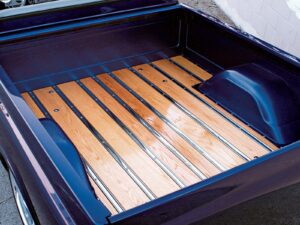
How To Finish A Truck Bed?
Things You’ll Need:
- Orbital electric hand sander
- Sandpaper, 180-grit
- Sandpaper, 100-grit
- 1 gallon boiled linseed oil
Step 1:
Using an orbital hand sander with 100-grit sandpaper, sand the bed of your truck. Before you stop sanding the bed up and down, using the grain, ensure that the surface is free of rough spots and splinters. Place the 180-grit sandpaper right on the sander and continue with the sanding until you can see that the wood’s surface has a dull sheen to it.
Step 2:
In order to get rid of any residual dust, use a soft clothe to wipe the bed down. As another option, you can make use of a leaf blower or air compressor to remove sanding dust.
Step 3:
Pick up the linseed oil and pour it gently and directly onto the bed of the truck. Allow it to spread out until it looks like the size of a baseball. Now, it’s time to bring in the soft clothing; you’ll have to start using it to rub the linseed oil into the wood. At the time you discover that the wood has absorbed the oil, don’t stop carrying out the process: pour on a little more and continue rubbing the oil into the wood. Do these until the wood depicts a dark color as a result of absorbing the oil. Wait for an hour.
Step 4:
In this step, you’d need to pour more of the linseed oil onto the bed. Wipe it way down. Continue the bed’s length until you’re sure that the bed has a “wet” look. If the bed hasn’t reached the point where it looks wet, continue with the application of the linseed. Wipe it in to the extent that the wood won’t be able to absorb more oil. Wait one week.
Step 5:
Again, you’ll have to take up the linseed oil and pour more of it onto the truck bed. Wipe it in the bed’s length. If you observe that it’s still soaking into the wood, continue applying more linseed oil: do this until the bed, again, looks wet. Wait for up two weeks to one month before applying another coat of oil. Carry out the application of the linseed oil every six months to one year or whenever you desire to have a richer, deeper finish.
Tip: When performing the application process, don’t get yourself bothered about any metallic area in the bed of your truck. The oil, linseed oil, will cause no harm to those parts. The same thing the oil does to the wood, finishing it, that’s the same thing it’d do to those metal parts. After you’re done applying the linseed oil, you can go ahead and, in the meantime, use your truck. It’s quite okay to do so.
Warning: Yes, the linseed oil is non-toxic, but it’s still necessary and advisable that you put on breathing protection — since you’ll be using large volumes.
What Wood Is Best For Your Bed?
You know how important it is for one to choose the right interior or paint color, right? That’s how important it is, as regards picking the best wood to use for your bed — if you have the intention to have a wooden truck bed.
In addition, it’s not just about looks alone; you also need to put “functions” into consideration.
1. Ash
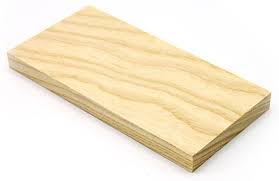 Are you among those in search of durable yet flexible wood? Then, you should go for ash, because it’s the kind of wood that’d fit perfectly. It comes with shock-absorber properties: these properties make it a great choice for people who intend to have the classic look in the bed of their truck but, at the same time, need a few more functions.
Are you among those in search of durable yet flexible wood? Then, you should go for ash, because it’s the kind of wood that’d fit perfectly. It comes with shock-absorber properties: these properties make it a great choice for people who intend to have the classic look in the bed of their truck but, at the same time, need a few more functions.
2. Black Walnut
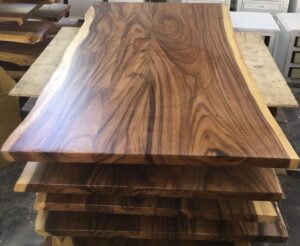 The Black Walnut is, on a normal note, used and reserved specifically for fine pieces of furniture and also, other expensive goods — but the natural warmth it possesses gives the bed of your truck a look that’s classic yet rugged. You can feature this type of wood on show trucks — trucks that spend most of their off-days in climate control garages.
The Black Walnut is, on a normal note, used and reserved specifically for fine pieces of furniture and also, other expensive goods — but the natural warmth it possesses gives the bed of your truck a look that’s classic yet rugged. You can feature this type of wood on show trucks — trucks that spend most of their off-days in climate control garages.
3. Oak
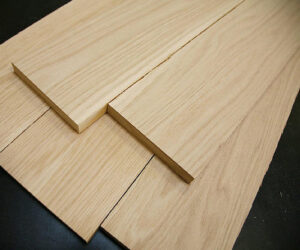 Among other woods, the oak stands as the most popular pick for a wooden bed. When the very first C/K trucks were launched in the year 1963, the oak wooden bed which they possess was designed in such a way that they’re able to withstand a lot of abuse from hauling items. A cool thing about this type of wood is, it matches with essentially everything.
Among other woods, the oak stands as the most popular pick for a wooden bed. When the very first C/K trucks were launched in the year 1963, the oak wooden bed which they possess was designed in such a way that they’re able to withstand a lot of abuse from hauling items. A cool thing about this type of wood is, it matches with essentially everything.
What Kind Of Strips Do You Need?
After you have chosen the wood that’s just right for your “wooden truck bed” project, it’s time to look for the kind of metal strip that can hold them together. The metal strip is, also, responsible for keeping out debris and moisture.
Below are the options tagged “most common:”
Speed Bump Aluminum Bed Strips
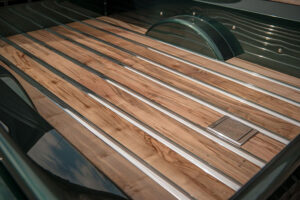 These bed strips are manufactured using feature hidden fasteners and extruded aluminium, to ensure that your truck bed has a sleek look. Also, they are polished — showroom polished — in bright-anodized aluminum.
These bed strips are manufactured using feature hidden fasteners and extruded aluminium, to ensure that your truck bed has a sleek look. Also, they are polished — showroom polished — in bright-anodized aluminum.
Flat Top Aluminium Bed Strips
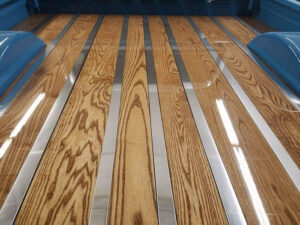 The difference between these strips and the speed bump aluminum bed strips is, in the flat top aluminum bed strips, the fasteners are not hidden. This gives the truck bed an old-fashioned look.
The difference between these strips and the speed bump aluminum bed strips is, in the flat top aluminum bed strips, the fasteners are not hidden. This gives the truck bed an old-fashioned look.
Steel Bed Strips
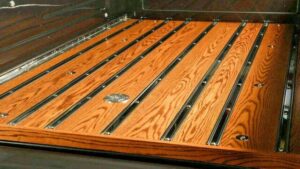 Plain steel bed strips should be the pick of those who plan on customizing the bed of their truck, as these strips can be evenly powder coated or painted.
Plain steel bed strips should be the pick of those who plan on customizing the bed of their truck, as these strips can be evenly powder coated or painted.
Stainless Bed Strips
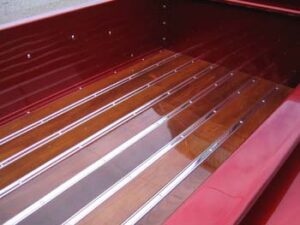 According to your truck’s original pattern, these stainless bed strips are punched and slow-polished.
According to your truck’s original pattern, these stainless bed strips are punched and slow-polished.
Frequently Asked Questions (FAQs)
How Do You Seal A Wooden Truck Bed?
In order to seal a wooden truck bed properly, one needs to make use of penetrating oil. Moisture can have a negative effect on truck beds. Now, traditional wood coatings such as shellac and varnish don’t penetrate the wood and can easily scrape off in rough use.
What Is The Best Wood For Your Truck?
The best wood you’d enjoy at your truck bed is Oak. The wood, Oak, is the most popular choice for a wooden truck bed for many good reasons. It’s good to use because it essentially fits into everything.
Are Wooden Flatbeds Legal In PA?
All you need to do is to get a few reliable, good iron and lumber, then build your own flatbed. In NW PA, a good number of truck owners opt for this alternative after their original truck bed has rusted out completely. It’s totally inspectable and legal. If you get issues from your inspection station over this, it means you live very far from South or East.
How Do You Keep Untreated Wood From Rotting?
Although the best choice for outdoor exposure is the natural weather-resistant wood, it doesn’t mean it’s not prone to decay — at some point. The only way one can properly use untreated wood of any type at all outside is with the addition of water-repellent preservatives, sealer, or paint that consist of UV protection.
How Do I Protect My Wooden Truck Bed – Conclusion
To recap, as a response to the question — How Do I Protect My Wooden Truck Bed? — we said:
For you to get the utmost protection for your wooden truck bed, you need to properly finish a wooden truck bed. You can find a step-by-step guide you can follow to ensure protection for your wooden truck bed.
That guide is what we have included in this article. Refer to this article whenever you’re looking at finishing a wooden truck bed and you’re in search of an answer for the question, How Do I Protect My Wooden Truck Bed?
Thanks for reading.

Joe lives and breathes cars and trucks. After many years working in the Auto industry, he decided that it is only right to share his knowledge with the public. As a qualified expert in trucks and cars, he started working for Truckile.com and is the main editor and publisher.






